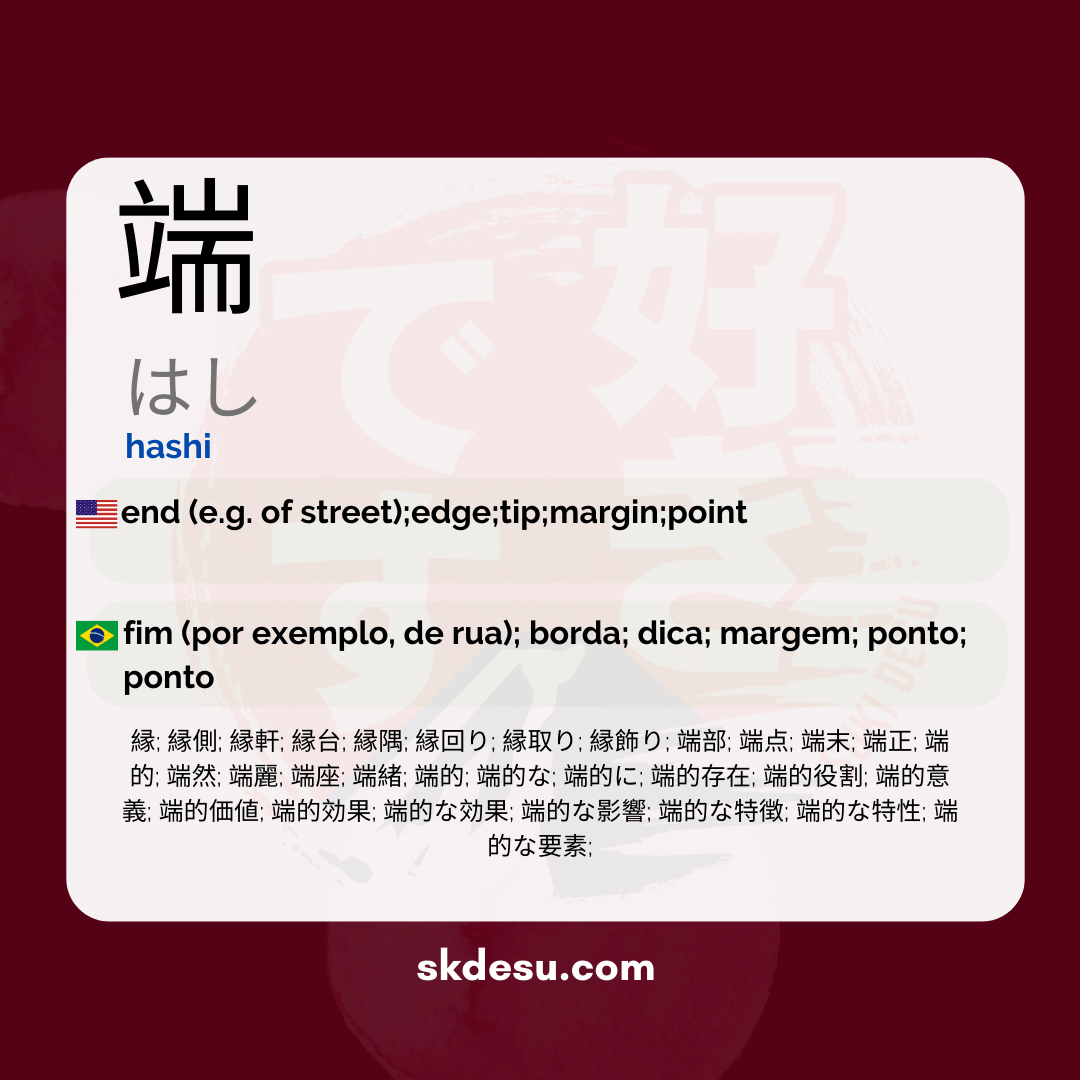Translation and Meaning of: 端 - hashi
The Japanese word 端[はし] may seem simple at first glance, but it carries meanings and uses that go beyond the basics. In this article, we will explore its meaning, origin, and how it is used in everyday life in Japan. Furthermore, you will discover cultural curiosities and tips for memorizing this term efficiently. If you are studying Japanese or just have an interest in the language, understanding 端[はし] can be more useful than you think.
Found in various contexts, from informal conversations to more formal expressions, this word has a significant presence in the language. Here at Suki Nihongo, we aim to provide accurate and relevant information for your learning. Let's uncover everything from its writing to practical examples that may appear in animes or everyday situations.
Meaning and uses of 端[はし]
端[はし] has a central meaning related to "end" or "tip." It can be used for physical objects, like the edge of a table (テーブルの端), as well as in abstract contexts, like the end of a period (月の端). This versatility makes the word appear frequently in different situations.
In everyday life, the Japanese use 端 to indicate something that is on the edge or at the limit. For example, when referring to someone sitting in the corner of a train car, it is common to hear "電車の端に座っている". This concrete usage helps to solidify the main meaning, but it is important to remember that the word can also have nuances depending on the context.
Origin and writing of the kanji 端
The kanji 端 is composed of the radical 立 (which means "to stand") combined with 耑, an ancient form that suggests the idea of beginning or extremity. This combination reflects well the concept of something that stands out or is at the edge. The reading はし is the most common, but the same kanji can also be read as "tan" in certain compounds, such as 端整 (tansei - tidy, orderly).
Interestingly, etymological research indicates that the character 端 already appeared in classical Chinese texts before being adopted in Japan. Over time, its use became established in the Japanese language, maintaining the notion of limit or final part. For those studying kanji, observing these details can help better understand not only this word but the entire Japanese writing system.
Tips for memorizing and using 端[はし]
An effective way to memorize 端[はし] is to associate it with everyday situations. Picture yourself at a train station: platforms usually have signs like "端までお進みください" (please proceed to the end). This kind of practical exposure helps to cement both the meaning and pronunciation.
Another tip is to pay attention to the kanji 端 in compositions like 端末 (tanmatsu - terminal) or 先端 (sentan - tip, forefront). These words share the idea of extremity, reinforcing the central concept. Watching dramas or animes can also be useful, as 端[はし] appears quite frequently in dialogues about location or position.
Vocabulary
Expand your vocabulary with related words:
Synonyms and similar words
- 縁 (En) - Connection, relationship, bond.
- 縁側 (Engawa) - Veranda or passage along the house, usually covered, that connects the interior with the exterior.
- 縁台 (Endai) - Low table that is used in outdoor spaces, often on balconies or patios.
- 端部 (Tanbu) - Edge or border of an object.
- 端点 (Tanten) - End point or extreme of a line or shape.
- 端末 (Tanma) - Terminal device in a communication network or system (like a computer).
- 端正 (Tansei) - Correction or precision in forms or characteristics, often referring to good appearance.
- 端的 (Tandeki) - Directly or clearly; concise.
- 端的な (Tandekina) - Direct or concise characteristics.
- 端的に (Tandekini) - In a direct or concise manner; clearly.
- 端的存在 (Tandeki sonzai) - Existence that is direct and uncomplicated.
- 端的役割 (Tandeki yakuwari) - Role or function that is clear and direct.
- 端的意義 (Tandeki igi) - Direct and clear meaning of something.
- 端的価値 (Tandeki kachi) - Value that is direct and unambiguous.
- 端的効果 (Tandeki kōka) - Effect that is clear and straightforward.
- 端的な効果 (Tandekina kōka) - Effects that manifest in a direct and clear manner.
- 端的な影響 (Tandekina eikyō) - Direct influence, without implications.
- 端的な特徴 (Tandekina tokuchō) - Characteristics that are clearly defined.
- 端的な特性 (Tandekina tokusei) - Properties that are direct and well-defined.
- 端的な要素 (Tandekina yōso) - Elements that are clear and straightforward, without complications.
Related words
Romaji: hashi
Kana: はし
Type: noun
L: jlpt-n3
Translation / Meaning: end (eg street); edge; tip; margin; point; point
Meaning in English: end (e.g. of street);edge;tip;margin;point
Definition: The end or ending of something.
Quick Access
- Vocabulary
- Writing
- Sentences
How to Write in Japanese - (端) hashi
See below a step-by-step guide on how to write the word by hand in Japanese. (端) hashi:
Example Sentences - (端) hashi
See below some example sentences:
Todan ni ame ga furidashita
Suddenly
Immediately began to rain.
- 途端に - immediately, the moment
- 雨が - rain
- 降り出した - it started to fall, it started to rain
Sentan gijutsu wa tsuneni shinka shiteimasu
State -of -the -art technology is always evolving.
Advanced technology is constantly evolving.
- 先端技術 (sentan gijutsu) - cutting edge technology
- は (wa) - Topic particle
- 常に (tsuneni) - always
- 進化しています (shinka shiteimasu) - is evolving
Kyokutan na iken wa sakkeru beki da
Extreme Opinions Should Be Avoid.
Extreme opinions should be avoided.
- 極端な意見 - "extreme opinions"
- は - Topic particle
- 避ける - "avoid"
- べき - "must"
- だ - affirmative form of the verb "to be"
Other Words of this Type: noun
See other words from our dictionary that are also: noun

